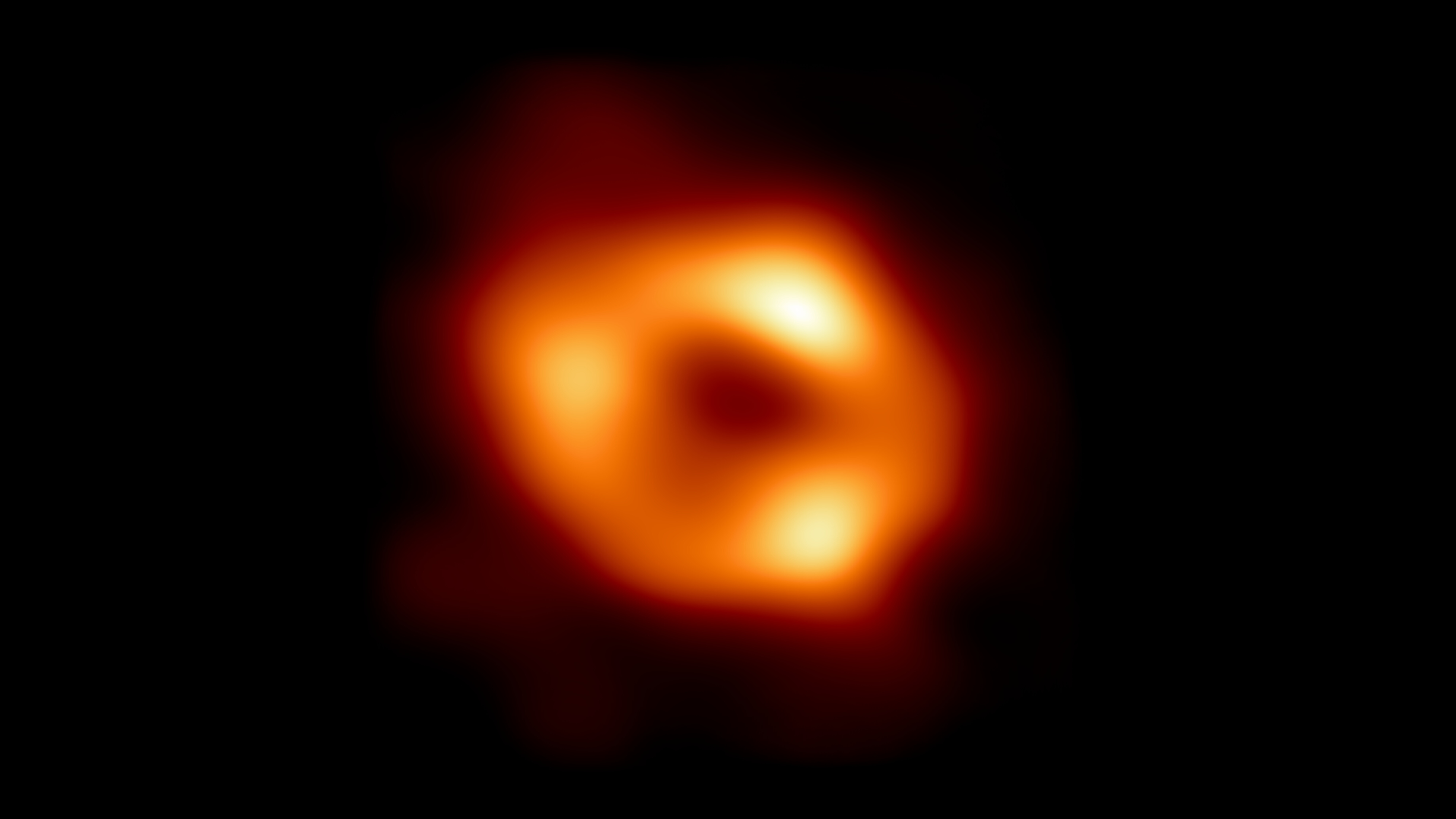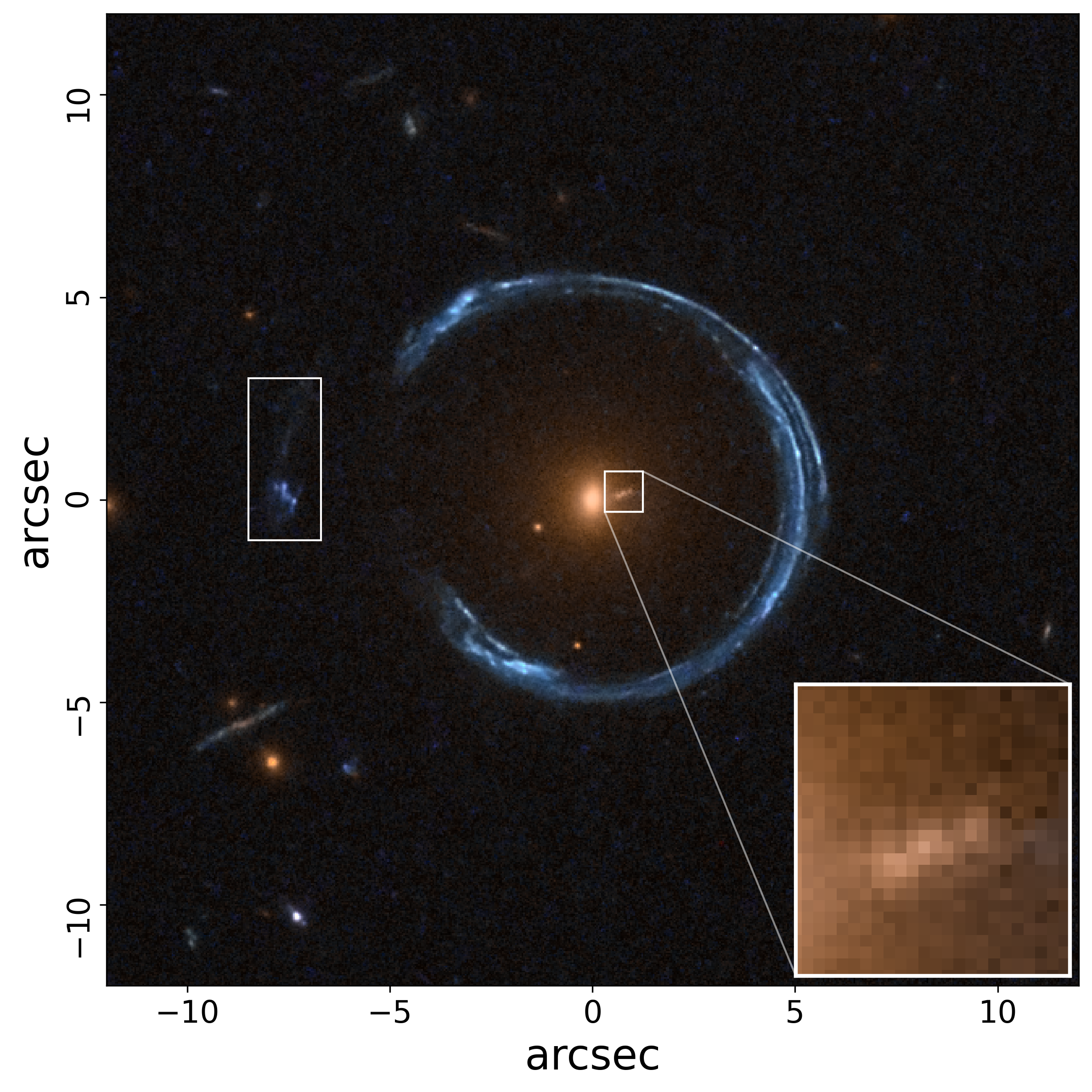The biggest black hole ever seen? Scientists find one with mass of 36 billion suns
"This is amongst the top 10 most massive black holes ever discovered, and quite possibly the most massive."

About 5 billion light-years away from where you're sitting, in one of the most massive galaxies on record, there exists an astonishing black hole. It was only just measured by scientists who managed to peer through the fabric of warped space-time — and it appears to hold a mass equivalent to that of 36 billion suns.
Yes, billion.
"This is amongst the top 10 most massive black holes ever discovered, and quite possibly the most massive," Thomas Collett, study author and a professor at the University of Portsmouth in England, said in a statement.
More specifically, the black hole is found in one of two galaxies that make up the Cosmic Horseshoe system and is what's known as a "dormant" black hole. This means it's a relatively quiet black hole; it isn't actively chomping on matter in its surroundings, as opposed to an active black hole that is accreting matter from a disk that circles it, known as an accretion disk. The black hole at the center of our Milky Way galaxy, Sagittarius A*, is also a dormant black hole — but, for context, it only holds the mass of about 4.15 million suns.
The fact that the Cosmic Horseshoe black hole is found in such a massive galaxy and that Sagittarius A* is found in our more modestly sized Milky Way is probably not a coincidence. In fact, the team behind the new measurement is hoping to learn more about the apparent size connection between supermassive black holes and their parent galaxies.
"We think the size of both is intimately linked," Collett said, "because when galaxies grow they can funnel matter down onto the central black hole. Some of this matter grows the black hole, but lots of it shines away in an incredibly bright source called a quasar. These quasars dump huge amounts of energy into their host galaxies, which stops gas clouds condensing into new stars."
This brings us to another key aspect of the team's findings: the way this black hole was measured to begin with.
Breaking space news, the latest updates on rocket launches, skywatching events and more!

The research team was able to utilize a unique approach that doesn't rely on the black hole being an actively accreting one. Without active feeding, black holes can kind of hide behind the veil of the cosmos. It is the accretion itself that usually gives these objects away. Such commotion produces lots of emissions, like X-rays, that scientists here on Earth can detect. Naturally, it's also far easier to measure the precise masses of black holes via such emissions.
However, there is one characteristic of black holes that even dormant ones can't suppress: their immense gravitational pull. And the greater the gravitational pull, the greater the warp in space-time, as predicted by Albert Einstein's general relativity theory.
Where Einstein comes in
In a nutshell, Albert Einstein's famous theory of general relativity explains the true nature of gravity. It suggests that gravity isn't quite an intrinsic, elusive property of an object that pulls things down. In other words, Earth itself isn't really pulling us down to the ground. Rather, general relativity states that objects with mass (all objects, including you and me) warp the four-dimensional fabric of space-time — and these warps influence the motion of other objects caught up in the folds.
For instance, imagine a trampoline on which you place a ball. That ball would warp the trampoline inward. Now, imagine placing a smaller ball on the trampoline. That smaller ball would fall inward as well, along the warped trampoline's fabric and sit right next to the original ball. The trampoline in this case is space-time, the original ball is Earth and the smaller ball is you.
The big caveat in this analogy, however, is that this trampoline exists in three dimensions. We'd need to scale this up to the four-dimensional universe for it to start representing reality more accurately, but our brains have a hard time comprehending that dimension visually.
Importantly for the team's new measurements, something that arises from warped space-time (in the fourth dimension, remember) is that physical matter isn't the only thing affected by the warps. Light gets affected, too — and that includes light emanating from galaxies, such as the other galaxy in the Cosmic Horseshoe. This is the effect the study team managed to take advantage of when spotting the newly confirmed black hole. Light from the Cosmic Horseshoe system's background galaxy was warped as it traveled past the foreground galaxy that contains black hole.
The Cosmic Horseshoe system is actually an iconic example of this effect, which is called gravitational lensing. Not only does this system have a strong version of this effect, but each galaxy involved happens to be perfectly aligned such that the light-warped background galaxy appears as almost a perfect ring around the foreground galaxy. When this happens, it's called an "Einstein Ring." So, we're seeing an "almost" Einstein ring in this case. It's more like ... an Einstein horseshoe?

After combining those gravitational lensing measurements with measurements of stars in the vicinity that appeared to be zipping around at high speeds, the researchers knew they were onto something. Though scientists have previously suggested a monster black hole lurks in the Cosmic Horseshoe system, concrete evidence of the object and of its precise size wasn't available until now.
"We detected the effect of the black hole in two ways — it is altering the path that light takes as it travels past the black hole and it is causing the stars in the inner regions of its host galaxy to move extremely quickly (almost 400 km/s)," Collet said. "By combining these two measurements, we can be completely confident that the black hole is real."
"Its detection relied purely on its immense gravitational pull and the effect it has on its surroundings," Carlos Melo, study lead author and a Ph.D. candidate at the Universidade Federal do Rio Grande do Sul in Brazil, said in the statement. "What is particularly exciting is that this method allows us to detect and measure the mass of these hidden ultramassive black holes across the universe, even when they are completely silent."
What's next?
There are quite a few ways to move forward on this work, one of which is, as mentioned, to reveal the link between galaxy size and supermassive black hole size — but another could be to zero in on the Cosmic Horseshoe black hole alone and learn how it became so utterly gigantic.
The Cosmic Horseshoe is what's known as a "fossil group," which refers to the end stage of the "most massive gravitationally bound structures in the universe, arising when they have collapsed down to a single extremely massive galaxy, with no bright companions," according to the statement.
The Milky Way and Andromeda galaxies will likely become a fossil group someday, seeing as they're likely on a path to colliding somewhere in the far future. That crash has recently been brought into question, but it's still a possibility. Nonetheless, the Cosmic Horseshoe could very well be a peek into our realm's final era.
"It is likely that all of the supermassive black holes that were originally in the companion galaxies have also now merged to form the ultramassive black hole that we have detected," said Collett. "So we're seeing the end state of galaxy formation and the end state of black hole formation."
The team's paper was published on Aug. 7 in the journal Monthly Notices of the Royal Astronomical Society.

Monisha Ravisetti is Space.com's Astronomy Editor. She covers black holes, star explosions, gravitational waves, exoplanet discoveries and other enigmas hidden across the fabric of space and time. Previously, she was a science writer at CNET, and before that, reported for The Academic Times. Prior to becoming a writer, she was an immunology researcher at Weill Cornell Medical Center in New York. She graduated from New York University in 2018 with a B.A. in philosophy, physics and chemistry. She spends too much time playing online chess. Her favorite planet is Earth.
You must confirm your public display name before commenting
Please logout and then login again, you will then be prompted to enter your display name.
